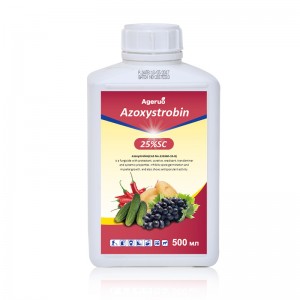Related reading: Azoxystrobin and Propiconazole Fungicide Rotation: Which is Better for Your Lawn?
There are two fungicides that are commonly used in lawn care and disease control, Propiconazole and Azoxystrobin, each with unique benefits and application scenarios. As a fungicide supplier, we will introduce the difference between Propiconazole and Azoxystrobin through the mechanism of action, main uses and advantages of these two fungicides.
What is Propiconazole?
Propiconazole is a triazole fungicide with the chemical formula of C15H17Cl2N3O2. Its mechanism of action is to inhibit the synthesis of ergosterol in the cell membrane of fungi, thus preventing the growth and reproduction of fungal cells.
Mechanism of action
Propiconazole is a systemic fungicide, which can be absorbed through the leaves and roots of plants and conducted in the plant body to prevent and treat diseases. It mainly inhibits the biosynthesis of fungal ergosterol, destroys the integrity and function of fungal cell membrane, and ultimately leads to the death of fungal cells.
Main applications
Propiconazole is widely used in agriculture, horticulture and lawn care, mainly for the control of a variety of fungal diseases, including:
Lawn diseases: brown spot, rust, blight, rot, etc.
Fruit tree diseases: apple black star disease, pear rust, peach brown rot, etc.
Vegetable diseases: powdery mildew, downy mildew, gray mold and so on.
Diseases of grain crops: wheat rust, rice blast, corn gray spot disease, etc.
Main advantages
Broad-spectrum: Propiconazole is effective against a variety of fungal diseases, including brown spot, rust, powdery mildew, etc.
Long shelf-life: It has a long shelf-life and can provide continuous disease control.
Strong penetration: It can quickly penetrate into plant tissues to prevent and treat potential diseases.
Usage
Propiconazole is usually applied as a spray to the surface of the lawn, several times a year, but care should be taken to avoid continuous use to prevent the development of fungal resistance.
What is Azoxystrobin?
Azoxystrobin is a methoxyacrylate fungicide with the chemical formula C22H17N3O5. Its main mechanism of action is to inhibit the mitochondrial respiratory chain complex III (cytochrome bc1 complex) of the fungus, blocking the energy transfer of the fungal cell and leading to the death of the fungal cell.
Mechanism of action
Azoxystrobin is a systemic fungicide that is able to be absorbed through the leaves, stalks, and roots, and is conductive in the plant. This conductivity allows it to protect emerging leaves and other parts of the plant that are not in direct contact with the agent, and it is highly effective in both preventing and treating fungal diseases.
Main Uses
Azoxystrobin is widely used in agriculture and horticulture, especially in lawns, fruit trees, vegetables and food crops. Its main control targets include:
Lawn diseases: brown spot, rust, rot, wilt, etc.
Fruit tree diseases: black star disease, moldy mildew, anthracnose, etc.
Vegetable diseases: gray mold, downy mildew, powdery mildew, etc.
Diseases of grain crops: wheat rust, rice blast, soybean brown spot, etc.
Main advantages
High efficiency: Azoxystrobin has rapid and strong bactericidal effect on many kinds of fungi.
Broad-spectrum: able to control a wide range of turf diseases such as brown spot, rust and rot.
High safety: low toxicity to the environment and non-target organisms, making it safer to use.
Usage
Azoxystrobin can be applied by spraying or root irrigation. The frequency of application is generally once every two weeks, but the specific frequency of use should be adjusted according to the actual situation of lawn diseases.
Propiconazole VS Azoxystrobin
Comparison of effects
Persistence: Propiconazole has a relatively long persistence period, but Azoxystrobin is more rapid-acting.
Broad-spectrum: Both have broad-spectrum fungicidal effect, but the effect may vary on different diseases.
Resistance management: Alternating Propiconazole and Azoxystrobin can effectively delay the development of fungal resistance.
Economic Comparison
Cost: Propiconazole is usually less expensive, but Azoxystrobin may be slightly more expensive due to its effectiveness and safety.
Cost-effectiveness: Depending on the specific disease and control needs of the lawn, choosing the right fungicide can be the most cost-effective.
Recommendations and precautions for use
Reasonable Rotation
In order to avoid the development of fungal resistance, it is recommended that Propiconazole and Azoxystrobin be used alternately. This will not only improve the control effect, but also prolong the service life of the fungicide.
Environmental protection
When using fungicides, attention should be paid to environmental protection. Avoid overuse, which may negatively affect the lawn ecosystem. At the same time, the safe use of fungicides should be followed to ensure that they are harmless to humans and animals.
Specific operations
Steps for Propiconazole use
Preparation: Mix Propiconazole with water according to the instructions.
Spray evenly: Spray evenly on the surface of the lawn with a sprayer.
Interval: After each spray, reapply at 3-4 weeks interval.
Azoxystrobin Application Procedure
Preparation: Mix Azoxystrobin with water according to the instructions.
Spraying or root irrigation: You can choose to apply by spraying or root irrigation.
Frequency control: After each application, reapply 2-3 weeks apart.
Summarization
Propiconazole and Azoxystrobin in lawn disease control in a reasonable rotation of the use of these two fungicides, not only can improve the effectiveness of the control, but also delay the emergence of fungal resistance, so as to realize the long-term healthy growth of the lawn.
Post time: Jun-21-2024








